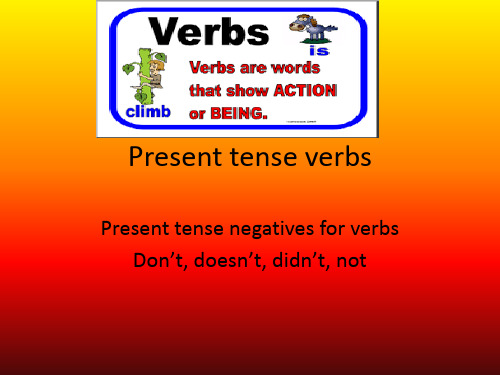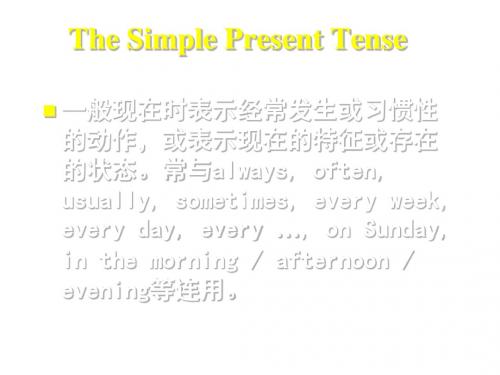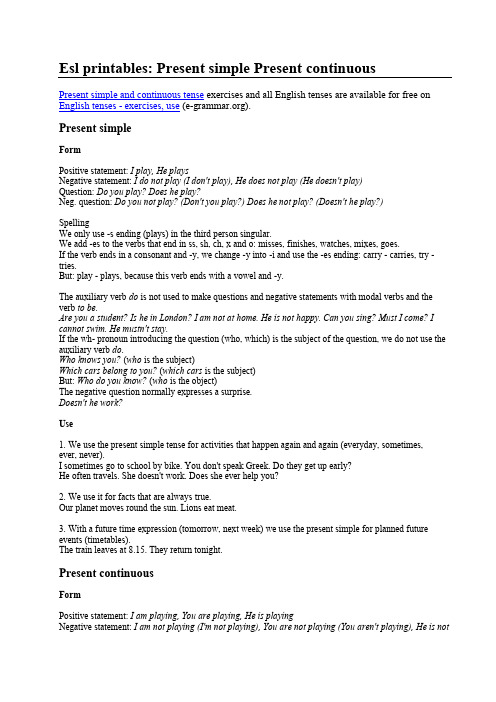01 Present tenses
- 格式:pdf
- 大小:373.69 KB
- 文档页数:29


tense用法及搭配Tense Usage and Usage PatternsTense is a grammatical concept that indicates the time at which an action or event takes place. The English language has various tenses, each with its own specific usage and patterns. In this article, we will explore the different tenses and how they are used in English.Present Tense:Let us begin with the present tense. The present tense is used to describe actions or events that are happening now or are generally true. For example:- I eat lunch at 12 o'clock.- The sun rises in the east.- She works as a teacher.These sentences depict actions or events that occur in the present or state a general fact.Simple Past Tense:Moving on to the past tense, which is used to describe actions or events that have already happened. The simple past tense is formed by adding "-ed" to the base form of regular verbs or using irregular verb forms. For example:- I walked to the park yesterday.- They studied for the exam last night.- She ate lunch an hour ago.These sentences show actions or events that occurred at a specific time in the past.Present Continuous Tense:The present continuous tense is used to express actions or events that are happening at the moment of speaking or during a specific time frame. It is formed using the present tense of the verb "to be" and the present participle form of the main verb. For example:- I am eating dinner right now.- She is studying for her final exams this week.- They are attending a conference tomorrow.These sentences demonstrate actions or events that are taking place in the present or in the near future.Past Continuous Tense:The past continuous tense is used to describe actions or events that were in progress at a specific time in the past. It is formed using the past tense of the verb "to be" and the present participle form of the main verb. For example:- I was reading a book when she called.- They were playing soccer when it started raining.- She was cooking dinner at 7 o'clock last night.These sentences portray actions or events that were happening at a particular time in the past.Present Perfect Tense:The present perfect tense is used to describe actions or events that happened at an indefinite time in the past or have a connection to the present. It is formed using the present tense of the verb "to have" and the past participle form of the main verb. For example:- I have visited Paris several times.- He has studied English for five years.- The company has just launched a new product.These sentences indicate actions or events that occurred in the past but have relevance or impact on the present.Past Perfect Tense:Moving on to the past perfect tense, which is used to describe actions or events that happened before a specific time or another action in the past. It is formed using the past tense of the verb "to have" and the past participle form of the main verb. For example:- She had already eaten dinner when I arrived.- They had completed the project before the deadline.- He had lived in New York before moving to California.These sentences illustrate actions or events that occurred before a certain point in the past.Future Tenses:Lastly, let us explore the future tenses. The future tenses are used to describe actions or events that will happen in the future.Simple Future Tense:The simple future tense is formed using the auxiliary verb "will" or "shall" with the base form of the main verb. For example:- I will go to the party tomorrow.- They will finish the project by next week.- She shall take the bus to work.These sentences express actions or events that will occur at some point in the future.Future Continuous Tense:The future continuous tense is used to describe actions or eventsthat will be in progress at a specific time in the future. It is formed using the auxiliary verb "will be" and the present participle form of the main verb. For example:- I will be working late tonight.- They will be traveling to Europe next month.- She will be attending a conference tomorrow morning.These sentences demonstrate actions or events that will be happening at a particular time in the future.Future Perfect Tense:The future perfect tense is used to describe actions or events that will be completed before a specific time or another action in the future. It is formed using the auxiliary verb "will have" and the past participle form of the main verb. For example:- She will have finished writing the report by Friday.- They will have graduated from college in two years.- He will have saved enough money for a vacation next summer.These sentences illustrate actions or events that will be completedbefore a certain point in the future.In conclusion, the English language has various tenses, each with its own specific usage and patterns. The present tense describes actions or events that are happening now or are generally true, the past tense describes actions or events that have already happened, and the future tenses describe actions or events that will happen in the future. Understanding tense usage is essential for effective communication in English, as it allows us to accurately express the timing of actions or events.。



Esl printables: Present simple Present continuousPresent simple and continuous tense exercises and all English tenses are available for free on English tenses - exercises, use ().Present simpleFormPositive statement: I play, He playsNegative statement: I do not play (I don't play), He does not play (He doesn't play)Question: Do you play? Does he play?Neg. question: Do you not play? (Don't you play?) Does he not play? (Doesn't he play?)SpellingWe only use -s ending (plays) in the third person singular.We add -es to the verbs that end in ss, sh, ch, x and o: misses, finishes, watches, mixes, goes.If the verb ends in a consonant and -y, we change -y into -i and use the -es ending: carry - carries, try - tries.But: play - plays, because this verb ends with a vowel and -y.The auxiliary verb do is not used to make questions and negative statements with modal verbs and the verb to be.Are you a student? Is he in London? I am not at home. He is not happy. Can you sing? Must I come? I cannot swim. He mustn't stay.If the wh- pronoun introducing the question (who, which) is the subject of the question, we do not use the auxiliary verb do.Who knows you? (who is the subject)Which cars belong to you? (which cars is the subject)But: Who do you know? (who is the object)The negative question normally expresses a surprise.Doesn't he work?Use1. We use the present simple tense for activities that happen again and again (everyday, sometimes, ever, never).I sometimes go to school by bike. You don't speak Greek. Do they get up early?He often travels. She doesn't work. Does she ever help you?2. We use it for facts that are always true.Our planet moves round the sun. Lions eat meat.3. With a future time expression (tomorrow, next week) we use the present simple for planned future events (timetables).The train leaves at 8.15. They return tonight.Present continuousFormPositive statement: I am playing, You are playing, He is playingNegative statement: I am not playing (I'm not playing), You are not playing (You aren't playing), He is notplaying (He isn't playing)Question: Are you playing? Is he playing?Neg. question: Are you not playing? (Aren't you playing?) Is he not playing? (Isn't he playing?)The present continuous tense is formed with the verb to be and the present participle (-ing ending). The negative question normally expresses a surprise.Isn't he working?Use1. We use the present continuous for an activity that is happening just now.I am learning English at the moment. You aren't listening! Why is he sitting here?2. We use it for an action happening about this time (today, this week), but not necessarily at the moment of speaking. It is a temporary activity.I am in London. I am staying at the hotel. (But just now you can be somewhere else.)She can't go out. She is writing her essay today. (But she can be having lunch at the moment.)You can't borrow this book today. Mary is reading it. (But not right now.)3. With a future time expression (soon, on Monday) we use the present continuous for definite arrangements in the near future. It is more personal than the present simple tense, because it expresses the speaker's plan.I am leaving soon. We are meeting on Monday.For more see 。

人教版八年级上册英语Unit 6 知识点语法归纳总结Unit 6 Grammar SummaryIn this unit, we have learned several important grammar points related to tenses, sentence structures, and word usage. In this summary, we will outline and explain these points to reinforce our understanding.1. Present tenses:- Present simple: Used for habitual actions and general truths. Formed with the base form of the verb, adding 's' or 'es' for third-person singular subjects.- Present continuous: Used for actions happening at the moment of speaking or temporary actions. Formed with the present tense of the verb 'be' (am, is, are) + the present participle (-ing form) of the main verb.2. Past tenses:- Simple past: Used for completed actions in the past. Regular verbs are formed by adding '-ed' to the base form, while irregular verbs have specific forms.- Past continuous: Used for actions that were in progress at a specific time in the past. Formed with the past tense of the verb 'be' (was, were) + the present participle (-ing form) of the main verb.3. Future tenses:- Will + base form: Used for future predictions, decisions, and promises.- Be going to + base form: Used for future plans or intentions.- Present continuous: Used for future arrangements or fixed plans.4. Gerunds and infinitives:- Gerunds: Verb forms ending in '-ing' that function as nouns.- Infinitives: Base form of the verb preceded by 'to' that can function as nouns, adjectives, or adverbs.5. Passive voice:- Formed with the auxiliary verb 'be' + past participle. The subject of the active voice sentence becomes the object in the passive voice.6. Reported speech:- Reporting verbs such as say, tell, ask, etc., are used to report what someone said.- Reported speech involves changing verb tenses, pronouns, time expressions, and place expressions.7. Conditional sentences:- Zero Conditional: Used for general truths and facts. Formed with present simple in both the if-clause and the main clause.- First Conditional: Used for possible events in the future. Formed with present simple in the if-clause and future simple (will + base form) in the main clause.- Second Conditional: Used for hypothetical or unreal events in the present or future. Formed with past simple in the if-clause and would + base form in the main clause.- Third Conditional: Used for hypothetical or unreal events in the past. Formed with past perfect in the if-clause and would have + past participle in the main clause.8. Comparative and superlative forms:- Comparative: Used to compare two things. Most adjectives add '-er' or use 'more' before the adjective. Irregular forms have specific comparative forms.- Superlative: Used to compare three or more things. Most adjectives add '-est' or use 'most' before the adjective. Irregular forms have specific superlative forms.Remember to practice these grammar points through exercises and conversation to develop a strong foundation in English grammar.。
Simple Present Tense 用法一、什么是simple present tense?Simple present tense是英语中最简单的一种时态,它表示的是习惯性的、经常发生的或者普遍的真理等情况。
在谈论日常生活中的习惯、常规或者事实时,通常会用到simple present tense。
二、simple present tense的构成1. 一般情况下,simple present tense的构成为主语加上动词原形。
例如:I play football every Sunday.(我每个星期天都会踢足球。
)She speaks French fluently.(她能够流利地说法语。
)2. 在第三人称单数的情况下,动词要加上-s或者-es后缀。
例如:He plays basketball after school.(他放学后会打篮球。
)She eats an apple every day.(她每天都会吃苹果。
)3. 在形容词性物主代词(如my, your, his, her, its, our, their)之后使用动词原形。
例如:I love my family.(我爱我的家人。
)They like their new house.(他们喜欢他们的新房子。
)4. 在一些特殊情况下,动词需要作出相应的变化。
例如:I go to the movies every weekend.(我每个周末都会去看电影。
)三、simple present tense的用法1. 表示经常性动作或习惯在谈论日常生活中的常规动作或者习惯时,常会使用simple present tense。
例如:She drinks coffee in the morning.(她早上喝咖啡。
)They usually go for a walk after dinner.(他们通常在晚饭后会去散步。
)2. 表示客观真理或普遍事实在表达客观真理或者普遍事实时,也会采用simple present tense。